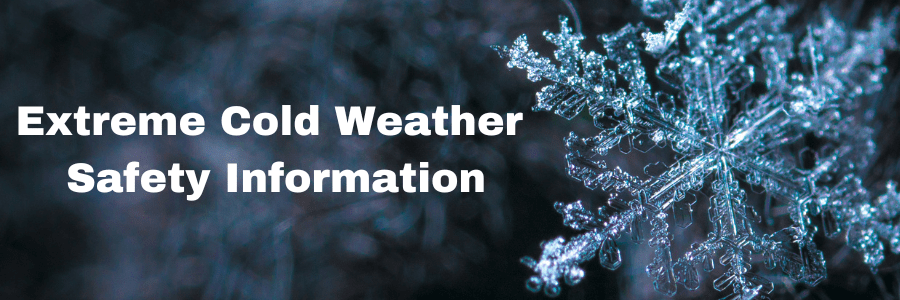When you are outside, frostbite and hypothermia are possible so you need to protect yourself.
1. Wear layers of loose-fitting, lightweight, warm clothing.
2. Wear a hat. Try to stay dry and out of the wind.
3. Cover your mouth to protect your lungs from extreme cold.
4. Mittens, snug at the wrist, are better than gloves.
To keep pipes from freezing on an outside wall:
1. Let hot and cold water trickle or drip at night from a faucet.
2. Open cabinet doors to allow more heat to get to un-insulated pipes under a sink or near an
outer wall.
3. Make sure the heat is left on and set no lower than 55 degrees.
4. If you plan to be away: (1) Have someone check your house daily to make sure the heat is still
on to prevent freezing, or (2) drain and shut off the water system (except indoor sprinkler
systems).
If Pipes Freeze:
1. Make sure you and your family know how to shut off the water, in case pipes burst.
2. NEVER try to thaw a pipe with an open flame or torch. Use a hair dryer instead.
3. Always be careful of the potential for electric shock in and around standing water.
Carbon monoxide poisoning is a silent, deadly killer claiming about 1,000 lives each year in the United States.
1. Install a carbon monoxide detector.
2. NEVER run generators indoors.
3. Open a window slightly when using a kerosene heater and follow the manufacturer’s
instructions.
4. NEVER use a gas oven to heat your home.
5. If your heat goes out, you can keep warm indoors by closing off rooms you do not need,
dressing in layers of lightweight clothing, and wearing a cap.
Wood-burning stoves, fireplaces and heaters:
1. Always keep a screen around an open flame.
2. NEVER use gasoline to start your fireplace.
3. NEVER burn charcoal indoors.
2 | P a g e
4. Do not close the damper when the ashes are hot.
5. Use only safe sources of alternative heat such as a fireplace, small well-vented wood or coal
stove or portable space heaters. Always follow the manufacturer’s instructions.
Animal and Pet Safety:
1. Bring pets inside
2. Provide shelter and fresh water
3. Keep salt away from paws
Vehicle Preparation:
1. Check your battery
2. Check your fluids (coolant, wiper fluid, oil, etc)
3. Check your tires
4. Have jumper cables
5. Pack a blanket
For more information please see:
Winter Weather | Ready.gov
https://www.redcross.org/get-help/how-to-prepare-for-emergencies/types-of-emergencies/winterstorm.htm
(Information courtesy of the National Weather Service)

